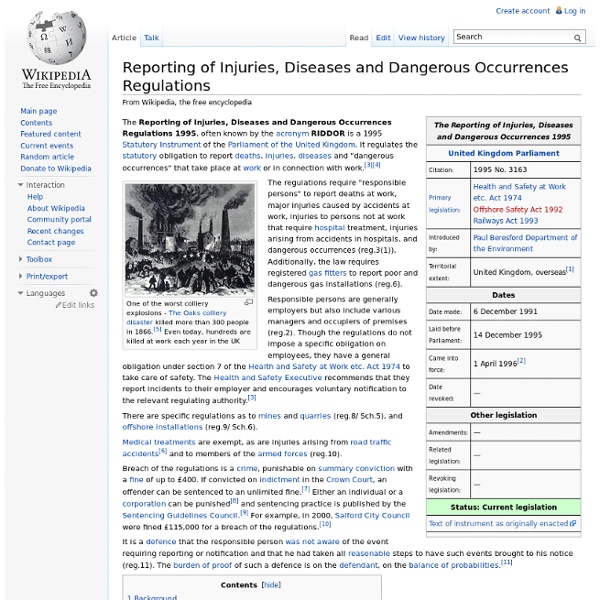Reporting of Injuries, Diseases and Dangerous Occurrences Regulations

http://en.wikipedia.org/wiki/Reporting_of_Injuries,_Diseases_and_Dangerous_Occurrences_Regulations
United States Environmental Protection Agency
The United States Environmental Protection Agency[2] (EPA or sometimes USEPA) is an agency of the U.S. federal government which was created for the purpose of protecting human health and the environment by writing and enforcing regulations based on laws passed by Congress.[3] The EPA was proposed by President Richard Nixon and began operation on December 2, 1970, after Nixon signed an executive order. The order establishing the EPA was ratified by committee hearings in the House and Senate.[4] The agency is led by its Administrator, who is appointed by the president and approved by Congress. The current administrator is Gina McCarthy.[5] The EPA is not a Cabinet department, but the administrator is normally given cabinet rank. The agency has approximately 15,193 full-time employees [6] and engages many more people on a contractual basis. Closeup of EPA building History[edit]
Provision and Use of Work Equipment Regulations 1998 (PUWER) - Work equipment and machinery
These Regulations, often abbreviated to PUWER, place duties on people and companies who own, operate or have control over work equipment. PUWER also places responsibilities on businesses and organisations whose employees use work equipment, whether owned by them or not. PUWER requires that equipment provided for use at work is:
COSHH basics - COSHH
COSHH is the law that requires employers to control substances that are hazardous to health. You can prevent or reduce workers exposure to hazardous substances by: finding out what the health hazards are; deciding how to prevent harm to health (risk assessment[1]); providing control measures to reduce harm to health; making sure they are used ; keeping all control measures in good working order; providing information, instruction and training for employees and others; providing monitoring and health surveillance in appropriate cases; planning for emergencies. Most businesses use substances, or products that are mixtures of substances. Some processes create substances. These could cause harm to employees, contractors and other people.
COSHH
Where a person suffers damage caused by a breach of a duty imposed by regulations, they have a cause of action in tort against the offender.[8] The Control of Substances Hazardous to Health (COSHH) regulations have been in place for more than 20 years and the scientific evidence suggests that over this time industry has, in general, been consistently reducing exposure to hazardous substances. European Legislation implemented[edit] The regulations implement the following European Union (EU) directives:[2] The regulations are consistent with Commission Directive 91/322/EEC requirements on indicative limit values.[2]
Environmental Protection Act 1990
The Environmental Protection Act 1990, a UK act of parliament relating to controlled wastes is the successor to the Control of Pollution Act 1974 and makes provision for the management of pollution from industrial processes. The Environmental Protection Act deals with issues relating to waste on land, defining all aspects of waste management and places a duty on local authorities to collect waste. As a business, you have a duty to ensure that any waste your company produces is handled safely and within the law. This is your ‘duty of care’ and it applies to anyone who produces, imports, transports, stores, treats or disposes of controlled waste from business or industry. The Duty of Care Regulations 1991 places a responsibility over these individuals to:
Provision and Use of Work Equipment Regulations 1998
Provision and Use of Work Equipment Regulations (PUWER 1998) Background[edit] The PUWER 1998 legislation replaced the 1992 regulations and seeks to address, control and prevent workers risk of injury and death from equipment they use during the course of their jobs. In addition to the requirements laid out in the PUWER legislation equipment used for lifting (such as fork lifts) is also subject to the requirements of the Lifting Operations and Lifting Equipment Regulations 1998. The regulations apply to any employer or self-employed worker who uses equipment at work[1] but not equipment used by the public which comes under the Health and Safety at Work Act 1974. PUWER covers all work equipment from office furniture through to complex machinery and company cars and is also applicable if a company allows a worker to use their own equipment in the work place.
Health and Safety at Work Act
Before 1974 approximately 8 million employees had no legal safety protection at work. The Health and Safety at Work Act 1974 provides the legal framework to promote, stimulate and encourage high standards of health and safety in places of work. It protects employees and the public from work activities. Everyone has a duty to comply with the Act, including employers, employees, trainees, self-employed, manufacturers, suppliers, designers, importers of work equipment. Employers' responsibilities The Act places a general duty to 'ensure so far as is reasonably practicable the health, safety and welfare at work of all their employees'.
Related:
Related:



